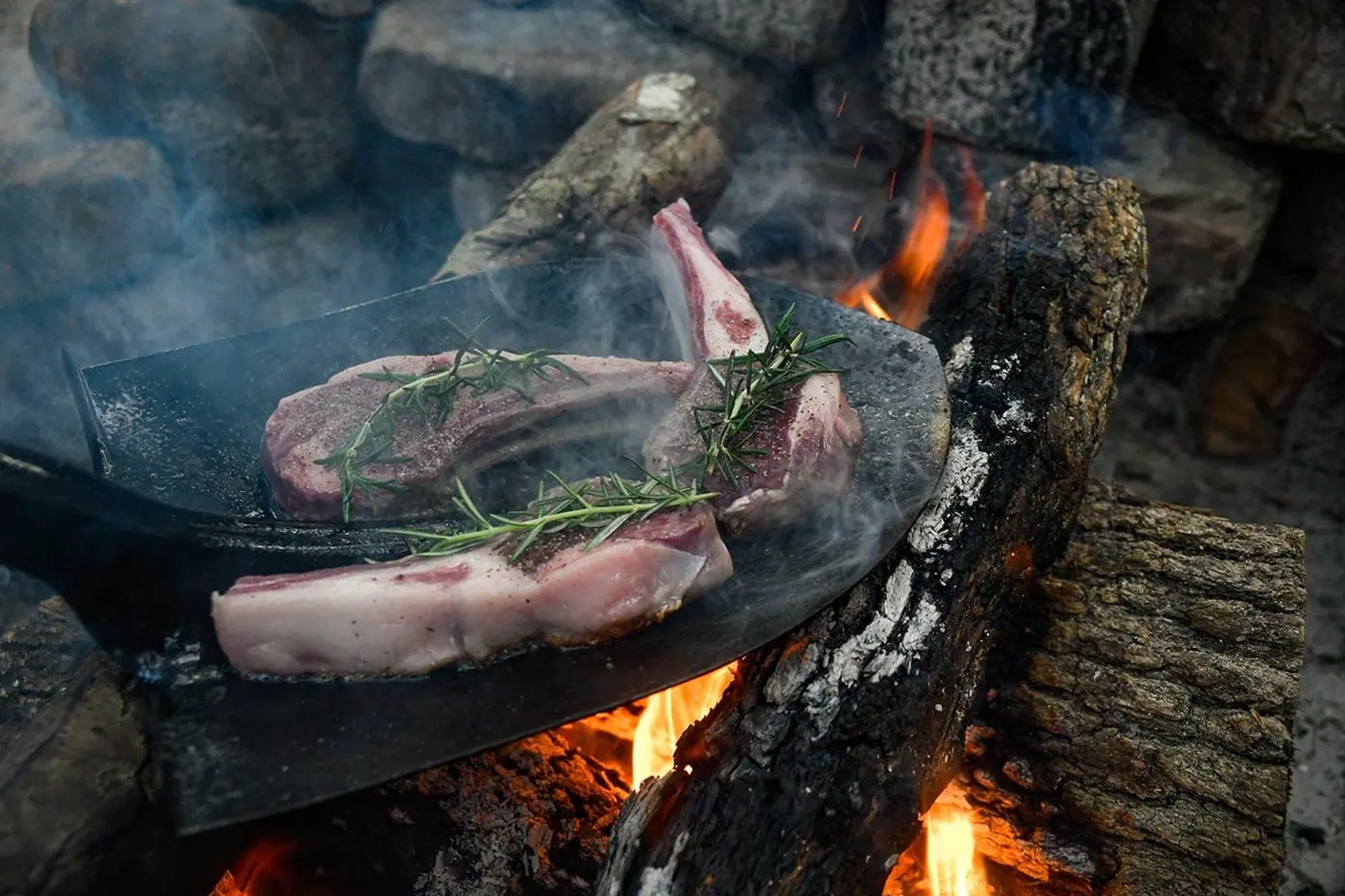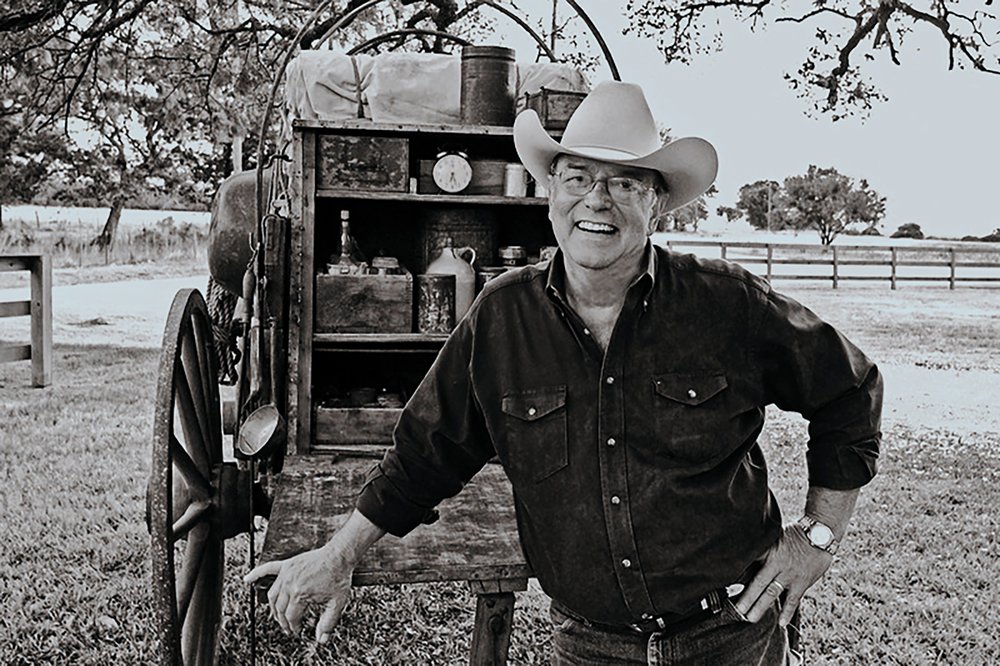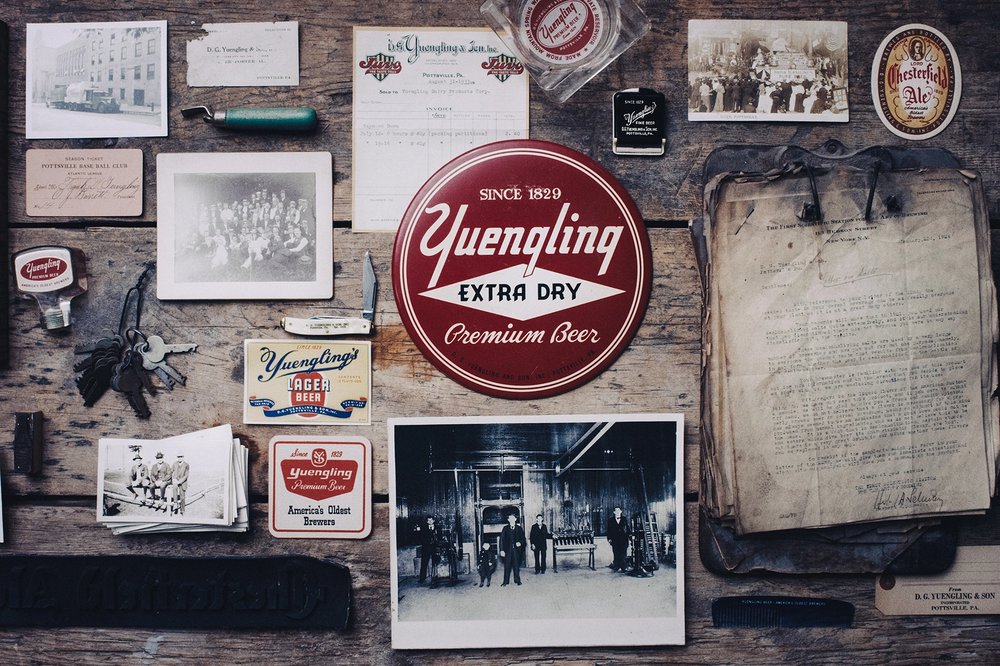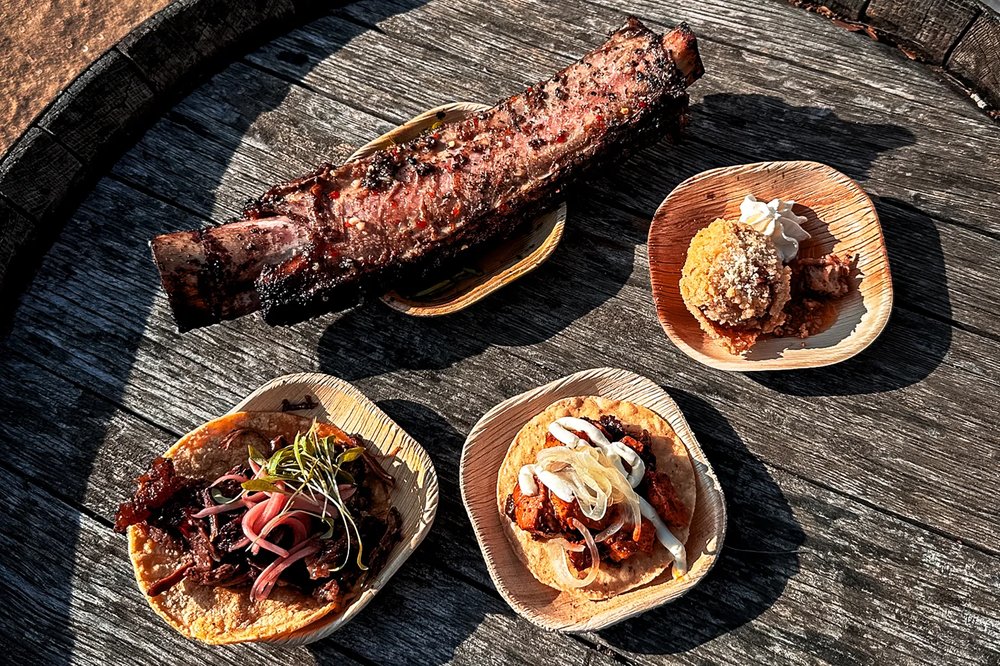As the founder of Barbecue University ™ (yes, it’s a real school), and host of Project Fire and Project Smoke on American Public Television, I own my fair share of grills. Sixty at last count—spread across homes and filming sites across North America. Monster gas grills and diminutive hibachis. Ceramic kamados, pellet grills, and even Brazilian rotisseries. So if you asked me to name my favorite grill, you might be surprised to learn it burns neither gas nor charcoal. For that matter, although it burns wood, it’s not really a grill at all. It has no gleaming stainless steel; requires no special tools, and you never assemble it twice the same way. I speak, of course, of the oldest grill/smoker/oven/range of all: the campfire. Here are some of my favorite campfire cooking tips and recipes.
Campfire cooking sustained us during our long evolutionary march from caveman to colonist to cowboy. It’s how you cook now if you’re a hunter, camper, or outdoorsman. And come the post-nuclear holocaust, it’s how we’ll cook after the last stocks of charcoal and propane have been depleted.
What is it about a campfire that strikes such a deep emotional resonance in the human psyche?
Millions of years ago, the campfire gave us light amid darkness, warmth when it was cold, protection against wild animals. Its inviting glow gathered us into families, tribes, and communities, inspiring us to tell stories around it, leading to literature, myth, and art. Its flickering flames entertained us—and when it comes to conveying a sense of well-being, it still trumps television and smart phones.
But most of all, it enabled us humans to do something no other creature can: cook.
Next to thermostatically controlled pellet grills and WiFi connected smokers, a campfire may seem hopelessly lacking in the sort of precision we’ve come to demand of our cooking technology. But cooking over a campfire (to that I should add, in a campfire) gives you unsurpassed versatility—and flavor.
Naturally, you can direct grill over a campfire (on a grate or a shovel or on the end of a green stick). Depending on whether you do it over flaming logs or glowing embers, you’ll get the pronounced smoke flavor of barbecue or the mild smoky flavor of grilling. You can roast vegetables caveman style—right in the embers. You can roast fish on planks or stakes stood upright around the campfire—a technique still used by the Native Americans of the Pacific Northwest.
You can smoke thin strips of meat on poles positioned downwind of a smoky fire, as the Plains Indians did—the origin of beef jerky. You can “bake” flatbreads on campfire-heated stones—the ancestor of modern pita. And once you’ve put your fire to bed, you can roast potatoes and other tubers in the hot ashes. Come the next morning, you rekindle that fire to brew coffee and fry your bacon and eggs in a cast iron skillet. I won’t even go into Dutch oven cooking (a subject for another column), which enables you to bake bread and make beans, pot roast, and even dessert in a campfire.
In a world of hopeless complexity (does anyone tinker with a car engine anymore?), a campfire is one of the few things you can build from scratch and use right away. It engages all your senses: the sound of crackling logs, the sight of dancing flames, the warmth of the fire, the scent of smoke, and of course, the inimitable flavor of food cooked over a wood fire. Added benefit: As you sit, cook, eat, and story-tell around a campfire, your clothes will acquire an aroma that lingers long after you’ve returned to civilization. I call it the original cologne, and I defy you to name another scent that’s as inviting—or manly.
Below you’ll find two surefire ways, sorry for the pun, to build a campfire. You’ll also find four of my favorite recipes that will turn your campfire into an outdoor kitchen.
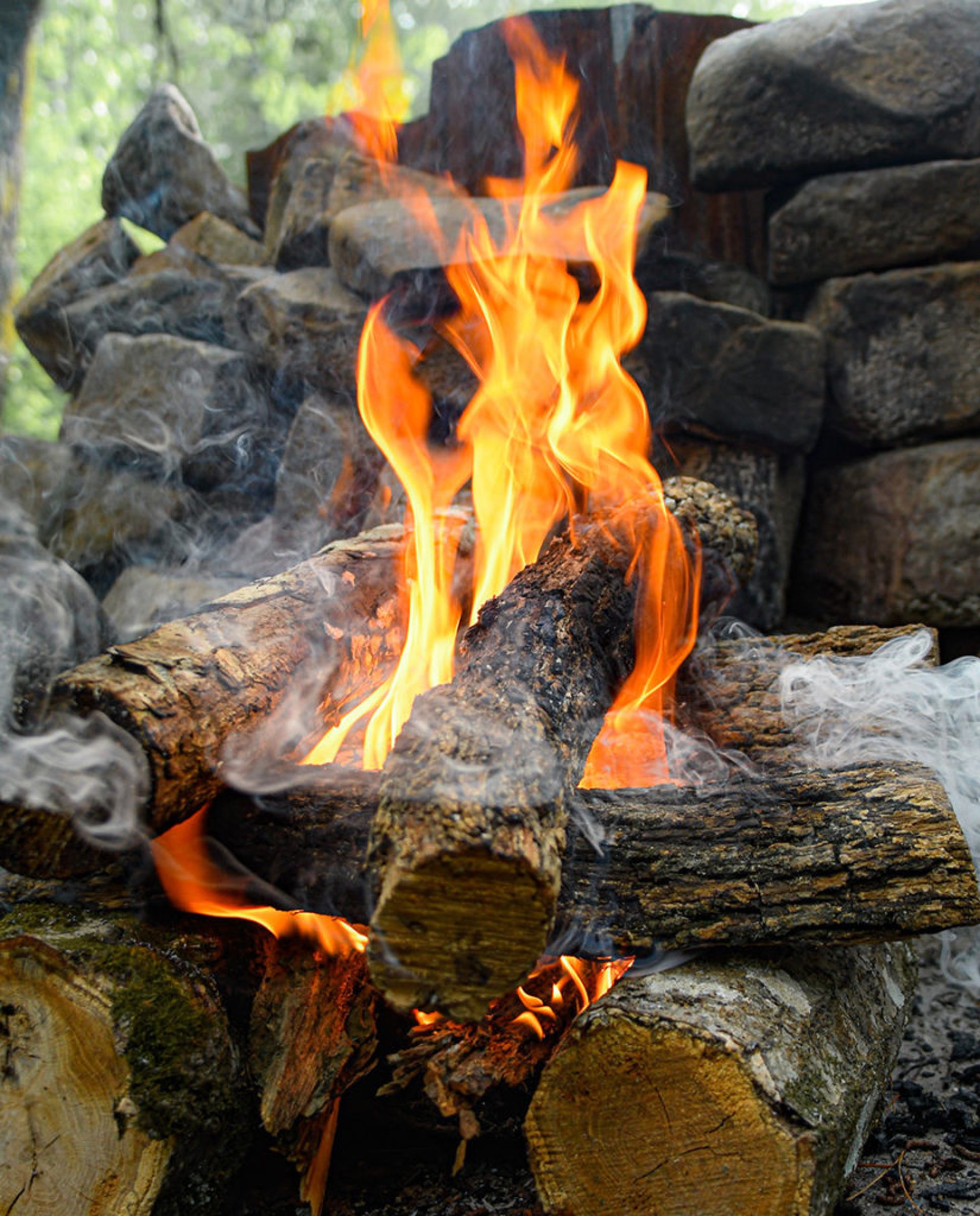
HOW TO BUILD AND COOK OVER A CAMPFIRE
Build your fire with hardwood logs—ideally seasoned (dry) and ideally split (they’ll burn better). I like the log cabin method: stack the logs (smaller to larger) in a square, as though you were building a log cabin in reverse. Alternatively, use the teepee method (logs stood upright and leaned in, smaller to larger, in a teepee configuration). Place crumpled newspaper or other tinder and kindling in the center and light it. You’ll have a great fire in 30 minutes.
Add logs in such a way that you leave plenty of space between them: good airflow is essential to a healthy fire. Some people like to cook directly over the flames, which gives you more charring and a more pronounced smoke flavor. (This is great for marshmallows.) For more control, let the fire (or at least part of it) burn down to embers, and grill over these as you would over charcoal. Position a Tuscan grill (a freestanding grate) over the embers. If it’s not a freestanding grate, rest it on stable rocks. Be sure to preheat the grate before you put on the food.
One final note: Be sure to extinguish your fire completely with water and earth before leaving your campsite.
RECIPES
TROUT ON A LOG
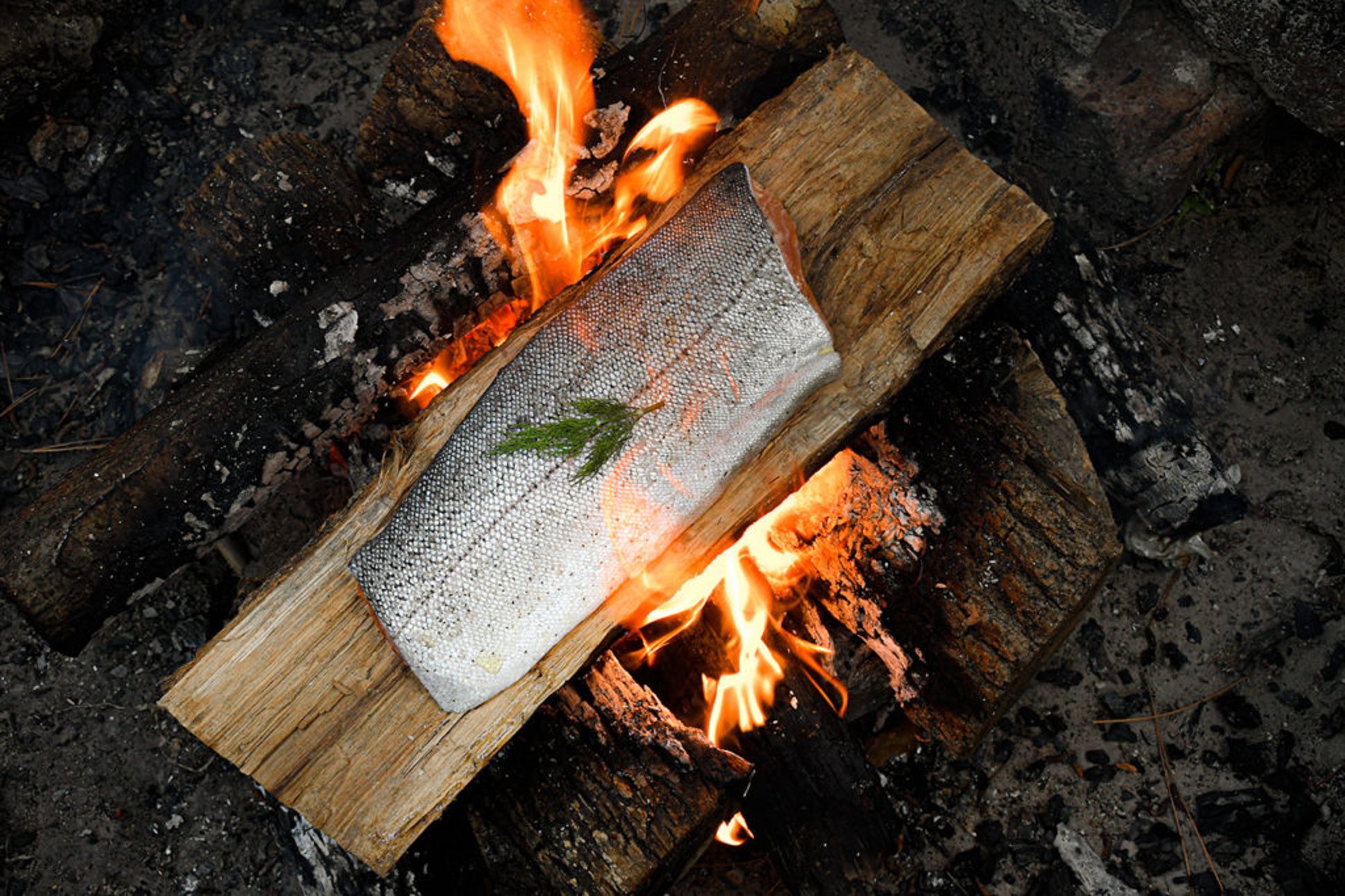
Here’s a French-Canadian twist on classic cedar-planked fish. I created it for a TV show I taped in Montreal a few years ago called Le Maître du Grill (The Grill Master). Instead of using a cedar plank, you use a split log. The flavor—and theatrics—are off the chart. Ideally, you’ll use a trout you caught earlier that day.
- 1 fresh trout (about 2 lbs.), cleaned and trimmed
- Coarse sea salt and freshly ground black pepper
- 1 lemon, half thinly sliced crosswise (remove any seeds with a fork), the other half cut into wedges
- 1 small bunch fresh dill or other herb
- 1 to 2 Tbsp. extra-virgin olive oil or unsalted butter
You’ll also need: 1 split log (the flat part should be about 4 inches wide and 16 to 20 inches long). Soak the log in a bucket of water or nearby stream for 2 hours, then drain well.
⦁ Build your campfire.
⦁ Generously season the inside and outside of the trout with salt and pepper and place the lemon slices and half the dill in the cavity. Lay the trout on the log and drizzle with olive oil or dot with thin slices of butter.
⦁ Place the log with the trout in the fire. Cook until the trout is sizzling and browned, 20 minutes, or as needed, for a whole trout. You may need to turn the trout over halfway through cooking, so both sides brown—do so with long-handled tongs or a spatula, wearing a grill glove to protect your arm.
⦁ Serve the trout right on its smoking log (place the latter on a metal tray). Top each fillet with a dill sprig and serve with lemon wedges for squeezing.
LAMB ON A SHOVEL

Serves 4
This singular way of grilling lamb originated in the Australian Outback, and it features two tools any rancher or woodsman would have on hand: a shovel and a campfire. I love how the wood smoke flavors the lamb while it cooks.
2 lbs. lamb chops (I prefer loin)
1 to 2 Tbsp. extra-virgin olive oil, plus more for drizzling
Coarse salt (kosher or sea) and cracked black peppercorns
2 Tbsp. chopped fresh rosemary
2 cloves garlic, peeled and minced
You’ll also need: A clean cast iron or carbon steel shovel (do not use aluminum)
⦁ Build a campfire with a good base of glowing embers. Feed fresh logs to the fire from time to time to generate plenty of wood smoke.
⦁ Lightly brush the lamb chops on both sides with olive oil. Season very generously on both sides with salt and pepper and crust with rosemary and garlic.
⦁ Heat the shovel blade in the fire. This serves two purposes. It helps clean and sterilize the cooking surface and preheats the metal so it will sear the meat. Pour a little oil on the shovel blade.
⦁ Arrange the lamb chops on the shovel blade, leaving an inch between each. Don’t overcrowd the shovel—it’s ok to work in several batches. Remember, in Australia, grilling isn’t just about getting a meal to the table—it’s a whole evening’s entertainment. Thrust the shovel over the fire or lay it on the embers. Cook the chops until done to taste: 3 to 5 minutes per side for medium-rare, turning with tongs.
⦁ Transfer the chops to a platter or plates. Drizzle with a little more olive oil. That’s all there is to it.
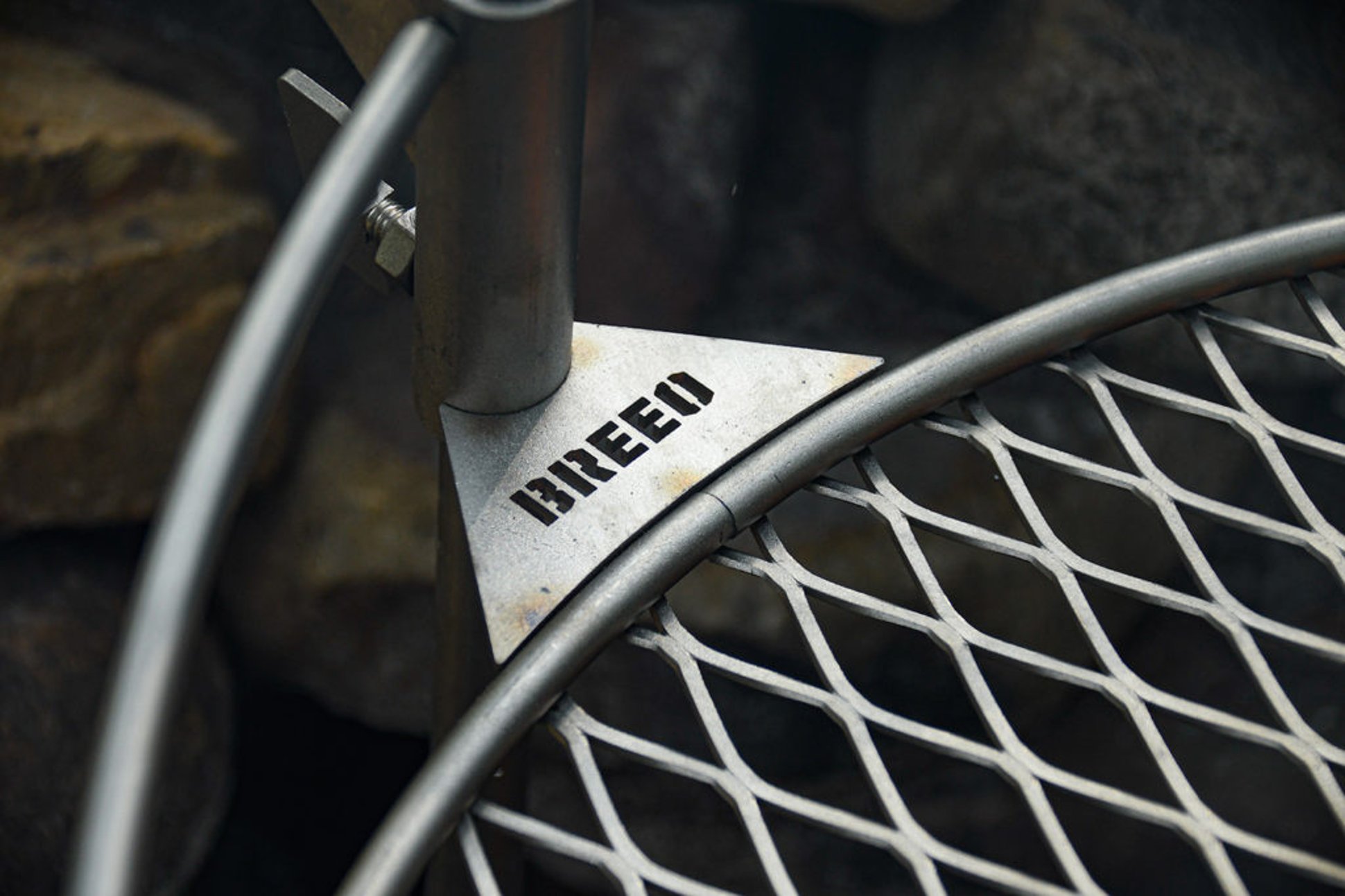
Introducing the Breeo Outpost: The Ultimate Campfire Grill
The Outpost is American made in its Lancaster facility in the heart of Pennsylvania’s Amish country. Crafted of 100-percent, high-grade 304 stainless steel and backed with a lifetime warranty, the Outpost is corrosion resistant and can be securely anchored in sand, dirt or grass to create a solid grilling platform making it ideal for grill masters looking for a portable, high-quality cooking option for life in the outdoors.
Adventurers of all kinds will appreciate the quality and craftsmanship of the Outpost, as well as its mobility that make it easy to bring it along for the ride. Whether in the backcountry, on the beach, tailgating or the backyard, the versatility of the Outpost elevates open-flame cooking to a new level.
The Outpost is available in two sizes: 19 inches (weighing 8 pounds) and 24 inches (weighing 14 pounds) and comes with a heavy-duty bag for easy transport. Stabilizing bars on the Outpost provide extreme balance while its adjustable grilling platform includes a post-locking mechanism to keep it firmly in place during use.
